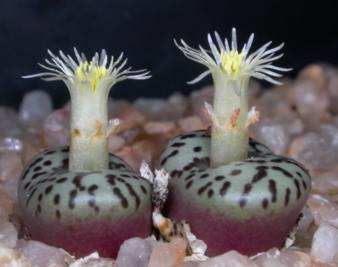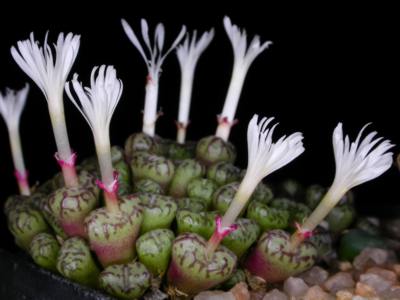Conophytym obcordellum subsp. obcordellum
Conophytum obcordellum (Haw.) N.E.Br. subsp. obcordellum
Family: Aizoaceae
Common names: dumpling
Introduction
Minute but spectacular; Conophytum species are amongst the most intriguing of all dwarf succulents and C. obcordellum is perhaps one of the most spectacular of them all. Its ornate markings and ease of growth make this a striking and rewarding little succulent pot plant.

Description
Description
Conophytums are about the most reduced flowering plants in existence. Some species exist only as a single pair of fused succulent leaves; others are multiheaded. Each head is shed and regenerated every year.

Conophytum obcordellum subsp. obcordellum grows usually in multiheaded clusters forming a small mat or mound 20-30 mm high. Each head is 8-20 mm in diameter with a small fissure on its upper surface from which the flower will emerge in autumn. The upper surface is usually a pale blue-green, grass-green or yellow-green, always decorated with a multitude of dark green-black lines and dots; the colour and intensity of these markings vary from one locality to another. In spring, as temperatures rise and humidity decreases, the plants descend into dormancy, withdrawing all the life from the leaf bodies and redirecting the sap and nutrients into new leaf bodies which then become sheathed over summer in the now dried remains of the old leaves. They remain in this state of dormancy, protected from the harsh desiccating summer conditions until autumn, when a single fragrant flower will appear from the fissure in the leaf surface. The creamy white flowers are nocturnal, meaning they close during the day and open at night to emit a sweet fragrance; the petals are up to 12 mm long. The fruits consist of a single 4-6-locular capsule containing many tiny dark hard seeds about the size of a grain of sand.

There are four subspecies of C. obcordellum: subsp. obcordellum which occurs in the greater Cedarberg area; subsp. stenandrum which occurs in southern Namaqualand; subsp. rolfii from the Eland's Bay area and subsp. ceresianum from the western parts of the Tanqua (Ceres) Karoo. Three of these are illustrated below, however, only C. obcordellum subsp. obcordellum will be described here.

It is not known how long these plants can exist in the wild, possibly for many decades, but in cultivation these plants can become ancient with the right care.
Distribution and habitat
Distribution description
Conophytums are distributed essentially throughout the winter-rainfall areas of South Africa (the three Cape provinces) and the southern parts of Namibia. This species, however, has its centre of abundance in the sandstones of the Cedarberg Mountains in the Western Cape.
Subsp. obcordellum and subsp . rolfii grow exclusively on sandstone rocks, while subsp . stenandrum grows on granite. Subsp . ceresianum will grow on a variety of geological substrates. In the wild they may regularly encounter frost, but generally they are absent from areas receiving regular snowfall.
Derivation of name and historical aspects
History
Conophytum literally means "cone plant" but the exact meaning of the specific name " obcordellum " is obscure - "inversely heart-shaped". The first plants of the genus were discovered and collected by the Scottish botanist Francis Masson in around 1776. These were sent to Kew and were grown in the living collections. However it was only some time later, in 1811, that the plant was properly described by an Englishman, Adrian Hardy Haworth. He described two different species, C. obcordellum and C. obconellum. However, a subsequent botanist from Kew, N.E. Brown, opted to combine the two into a broader species concept which is well accepted today.
Ecology
Ecology
This species tends to form a small tight cluster of heads forming a mat or small mound that secures itself to rock faces or in rock crevices. Known as obligate rock dwellers, they don't have to compete with other plants for water, space, soil or light. They are found generally growing on east-, south- or west-facing rocky outcrops - very seldom north-facing (too hot). They are almost always found growing amongst lichens and mosses. Their flowers are pollinated by nocturnal moths that are attracted by a nocturnal scent while during the day the flowers are scentless and remain closed.
Growing Conophytym obcordellum subsp. obcordellum
Grow
This Conophytum is very easy to grow and very rewarding to the novice and the advanced grower alike. They bulk up quickly and will outgrow the pot if not kept in check. They enjoy being grown in either plastic or clay (dry out more quickly) pots with good drainage holes. The soil medium should be essentially mineral with very little organic matter - decomposed rock (granite/sandstone etc.) is best with both fine and coarse particles. The drainage should be fairly good but should retain some moisture.
They can be grown in full sun in winter but dappled light or light shading is preferable to prevent burning. In the summer months they should be shaded to protect them from overheating in their small pots. During the winter months, while they are actively growing, watering (with rain water preferably) can be done by means of once-monthly drenching or simply regular misting with a spray bottle which is preferable - this simulates fog conditions in their natural habitat. In summer they should be kept essentially dry, but occasional light misting is important to keep them hydrated.
Conophytums can be very easily propagated from seed and cuttings. Seeds mixed with a teaspoon quantity of fine sand can be sown in autumn thinly on the soil surface. This germination medium is quite simply a well-drained sandy medium similar to what the mature plants would grow in. Keep them very moist for the first few weeks with regular (twice-daily) misting and use a fungicide to prevent them from damping off. After a few months the tiny spherical seedlings will start to take shape and harden off. Watering can be reduced to once every few days, allowing the soil to dry out slightly between waterings. Cuttings can be taken anytime during the growing season - no rooting hormones are necessary.
References
- HAMMER, S. 1993. The genus Conophytum . Succulent Plant Publications, Pretoria
- HAMMER, S. et al . 2002. Dumpling and his wife; new views of the genus Conophytum. EAE Creative Colour Limited.
Credits
Adam Harrower
Kirstenbosch National Botanical Garden
November 2012
Plant Attributes:
Plant Type: Succulent
SA Distribution: Western Cape
Soil type: Sandy
Flowering season: Autumn
PH: Acid, Neutral
Flower colour: White
Aspect: Full Sun, Morning Sun (Semi Shade), Afternoon Sun (Semi Shade)
Gardening skill: Easy
Special Features:
Horticultural zones








Rate this article
Article well written and informative
Rate this plant
Is this an interesting plant?
Login to add your Comment
Back to topNot registered yet? Click here to register.